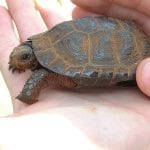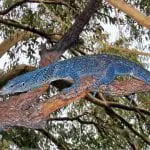Scientific Facts
| Common Name | Blessed Dart Frog |
| Scientific Name | Ranitomeya benedicta |
| Life Span | Over ten years |
| Size | 1 ¼ inch |
| Habitat | Lowland rainforests |
| Country of Origin | Pampas del Sacramento in southern Loreto and the eastern part of San Martin Region in northeastern Peru |
Physical Description
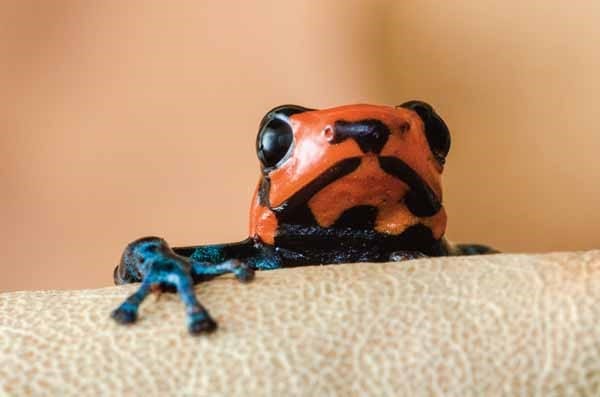
The Blessed Dart Frog is also known as the blessed poison dart frog. This is classified as a thumbnail frog and has a striking black, red, and blue coloration. Its appearance seems to be warning people to keep away because of the toxins that it possesses. But despite this, the blessed dart frog remains as one of the favorite pets kept in captivity.
An adult female blessed dart frog measures around an inch and a quarter while juvenile frogs are just ¾ of an inch long! These frogs have a consistent color and pattern. This frog has a bright red head with a blue and black body.
Determining the gender of the blessed dart frog is easily done when the frogs are older. Female frogs are larger than males because of these lay eggs more frequently.
Collecting blessed dart frogs as a hobby started in 2009. The hobby quickly bloomed, considering that this frog was just discovered in 2005 and described in 2008.
Life Span
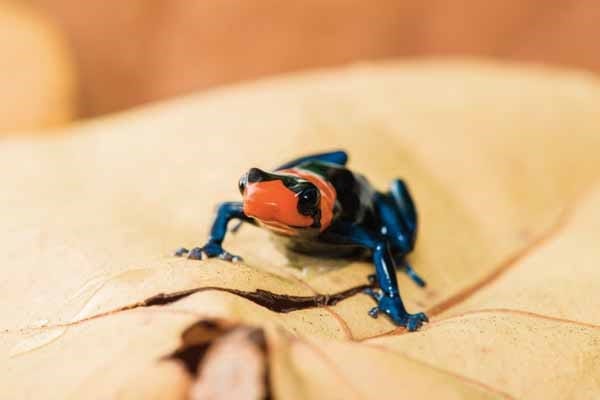
The blessed dart frog is capable of living up to 5 to 8 years, but there are some reports that this frog can live over 10 years in captivity. Usually, blessed dart frogs sold in pet shops and online exotic pet sites are around 2 to 3 months old.
Eggs
A female lays her eggs on a smooth surface of rocks and plants near water or in water. She usually lays about 4 to 8 eggs in one clutch.
Tadpoles
Soon, eggs become tadpoles. These will feed on dead fruit flies and even on unfertilized eggs if these are left to be with adults. These swim to find food, and this makes them easy prey to fish, small water lizards, and other small water animals.
Juveniles
The tadpoles will soon become larger, will lose their large tails, and will soon crawl on land. Juvenile frogs look very much like their parents; the only difference is their size and striking colors.
Adults
Adults are no more than two inches long and have very vibrant red and black or red and blue colors. The frog’s body is slender, and its thin legs allow it to jump high. A distinct black band is found around its head, covering its eyes, looking like a bandit.
Eating Habits
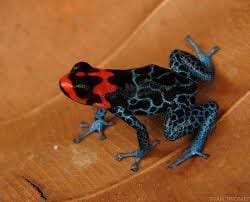
Similar to most poison dart frogs, the blessed dart frog prefers to eat small food. This thumbnail dart frog will eat fruit flies, isopods, springtails, and pinhead crickets. Experts recommend dusting food with supplements or multivitamins.
Sleeping Habits
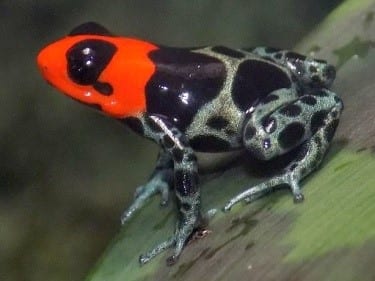
Poison dart frogs sleep in the evenings and eat, hunt, and mate in the mornings. In captivity, you can decorate your pet’s terrarium in the most natural way as possible so your frogs can sleep in logs, under rocks, or large leaves.
Water
A poison dart frog is a terrestrial frog; therefore, it won’t require a swimming area. It drinks water from a small dish or moisture found on the walls of the tank or from the plants and other items inside its tank.
Development, Reproduction, and Breeding

Blessed dart frogs are not for average pet owners because these could be tricky to breed. Sometimes, the blessed dart frog may breed too much and thus can be difficult to handle.
Blessed dart frogs are often bred in groups. A male frog will call to attract a female. The male lures her to a suitable place where she can lay her eggs and then the two mate. The female lays 4 to 8 eggs on a smooth surface
Common Health Problems

Bacterial Infections
Signs of bacterial infection include weight loss, restlessness, and the presence of lumps or any irregularities on the skin.
Parasites in the Gut
Symptoms of parasites in the intestines include restlessness, watery droppings, and hiding in the water. Parasites are present in the intestine, but these can cause disease when the frog is weak. Aside from treating your pet, you also need to clean the terrarium. Ask your vet for the best chemical treatment to remove parasites inside the tank.
Worms
Symptoms of worms can be weight loss and dry skin. Your vet will provide medications to be dissolved in water and applied to the frog directly for a week or more.
Wounds
Wounds can be due to fights, cuts, or abrasions. Signs are flesh-colored spots on the toes, nose and any part of the skin. A vet can recommend a treatment/disinfectant to treat wounds.
Hypothermal Problems
This is due to incorrect temperature and humidity inside the tank. Signs could be listlessness and inability to eat. Correcting temperature and humidity is necessary. Use a digital thermometer and hygrometer to correctly measure temperature and humidity.
Spindly Leg Syndrome
This is a condition present in young frogs where the front legs are skinny. This is usually due to poor nutrition, starting from the frog’s parents.
Fungus on skin
Or red leg Pseudomanas hydrophilia is a fungus present on the skin. Take your pet to the vet at once for proper treatment and clean and disinfect the tank as well.
Preventing Illness
The illness must be prevented by providing good nutrition, enhancing temperature and humidity inside the tank, and offering supplements to your pet. Take your pet to the vet, preferably to an exotics pet vet to get proper treatment right away.
Behavior

Can be housed in groups
Frogs can be placed in groups as long as you have enough space. Experts recommend 5 gallons of space per frog for a healthy dart frog environment. A group of dart frogs have a social dynamic and may change depending on the group’s needs.
Females may eat eggs
It’s not yet known why female dart frogs may eat the eggs of other females. Also, female dart frogs lay eggs in the same egg canister as other females, which may also be a clue as to why they eat the eggs of other females.
With a quiet call
Dart frogs have a quiet call or a nearly-silent call, and it is unknown as to why they do this. Meanwhile, some dart frogs have louder calls, and this may be heard even from across the room.
Habitat
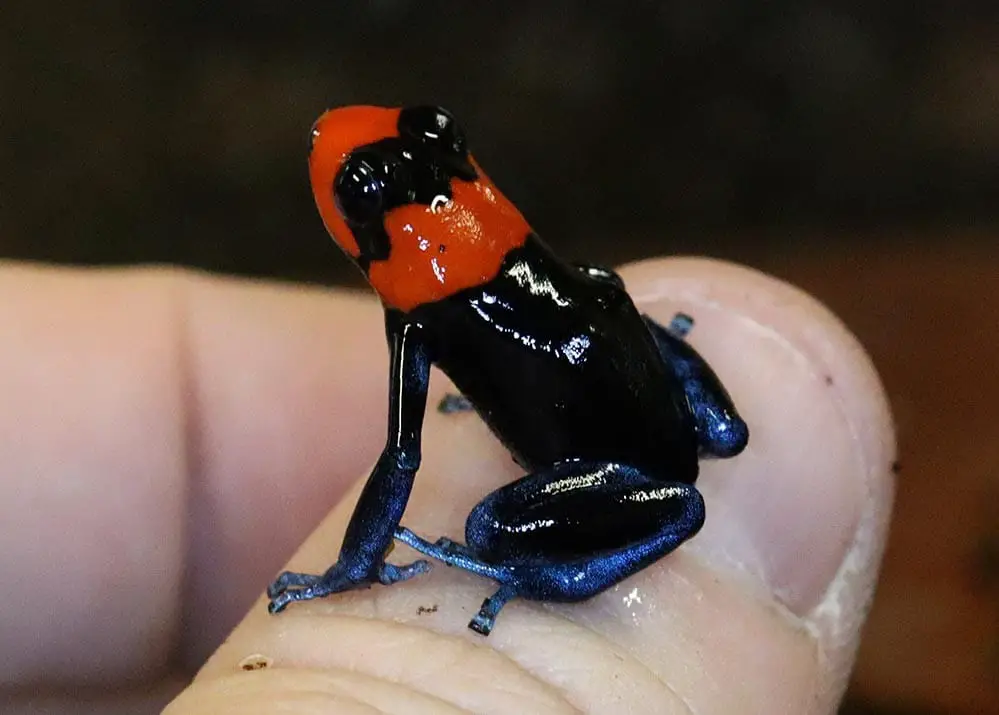
A recommended tank is a 10-gallon terrarium for two to three blessed dart frogs. These are terrestrial frogs and will need all the space they can get. Add natural accents inside the terrarium like a small log, plants, and rocks to mimic its natural habitat. For breeding frogs, place a large water dish or create a terrarium with water where females can lay her eggs.
Temperature and Humidity
Blessed dart frogs can tolerate a temperature of 65 to 80 degrees Fahrenheit. These are more comfortable in temperatures in the mid 70 degrees Fahrenheit. Never leave temperatures higher than 85 degrees.
Meanwhile, like most poison dart frogs, blessed dart frogs need a humidity range of 80 to 100%. These frogs may tolerate humidity of 50% but only for a short time and if your pets have access to water. Periods of low humidity and no access to water inside the tank can kill your dart frogs.
Availability – Where to Get One?
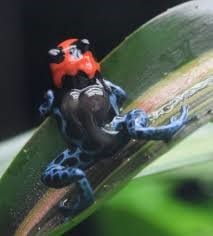
You can get a blessed dart frog from a local pet shop or an online pet shop. The price of a blessed dart frog ranges from $90 to $150 depending on the size, gender, and marks on the skin.
How to Care for a Blessed Dart Frog?
- Provide the best tank/terrarium environment. Your pet won’t survive without the right lighting, temperature, and humidity.
- Use a digital thermometer and hygrometer to make sure that your tank has the ideal conditions to keep your frog healthy and happy.
- Feed your frogs the right kind and size of food. Supplements and nutrients may be dusted over the food before feeding your frogs.
- Always keep the tank clean. Perform general cleaning at least every month with a special cleaning solution provided by your vet.
- Take your frog to an exotics vet for proper care.
FAQs
Can you keep poison dart frogs as pets?
Yes, poison dart frogs can be kept as pets. For some reason, when poison dart frogs are kept in captivity, they no longer have poison.
How many dart frog species are there?
Over 100 poison dart frog species are documented, including frogs that live in the Amazon forest. Each of these frog species has specific colors and markings.
What makes dart frogs poisonous?
Dart frogs are poisonous because of their diet. These frogs eat insects that have poison or toxic chemicals in their bodies, and the dart frog will eat these insects without being harmed.
Can a dart frog kill a human?
A species called golden poison frog has enough poison that can kill 10 adult men. This is the most poisonous animal alive.

